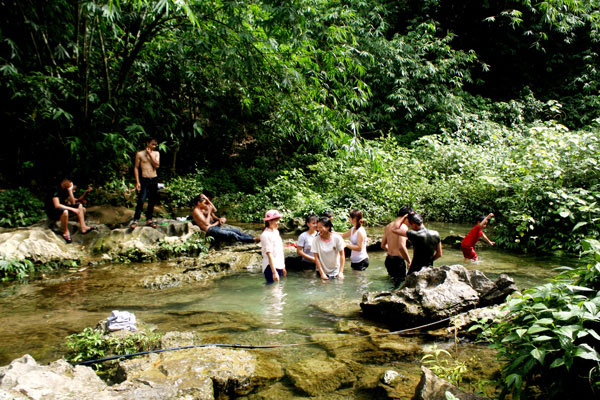
(HBO) - Bai Cai stream in Phu Luong commune has recently become a popular destination for local residents in Lac Son district’s remote communes during scorching summer days.
Situated
in Cai hamlet, Phu Luong commune, Lac Son district, and
200 metres from Phu
Luong market, Bai Cai stream can be accessible by provincial road No. 436
through a trail opposite the Phu Luong market or via inter-hamlet road from
Khai hamlet.
The bumpy roads with a lot of tyre tracks indicate
that Bai Cai has long become an ideal place for people during summer days.
People look completely at ease when resting at the fresh stream which runs from
the lush mountain foot and is surrounded by green shade of trees, boulders and roots
of ancient trees.
Photo: Boasting untouched beauty and
fresh water, Bai Cai stream has become an ideal place to escape summer heat.
The stream
gets more crowded at noon. According to Bui Van Than, a local resident living near
Bai Cai, the stream welcomes hundreds of people, mainly youths, at peak time.
Along with local people, the stream has been frequented by many others from
neighbouring districts such as Tan Lac.
More than 30 people were bathing in the stream when we arrived. "The water is a
little bit cold. Despite muggy weather, I had to stay out in the sun before
bathing in the stream again”, said Bui Van Hung from
Gia
Mocommune, Tan Lac district. This was the fifth time Hung had chance to go for a
bathe in Bai Cai stream.
Among those who are enjoying a day off at Bai Cai stream is Quach Thi Liep from
Muong Thuong hamlet, Dinh Cu commune. Liep and her six family members and
friends often visited Bai Cai during the summer. "My house is
12 km away and since knowing
about Bai Cai, we come to take a bath at the stream every summer. We really
enjoy the cool and clear water and beautiful landscapes here”, she said.
"But it is difficult to get here. If the entrance road
is improved, more people will visit”, she added.
For the family of Bui Thi Xuyen from Quyen hamlet, Phu
Luong commune, Bai Cai stream has become a friend gifted by "Mother Nature”.
The stream has been a place for her family – husband, wife and son – to rest
and get relaxed every noon.
"In summer, it is very hot at noon. We can barely
sleep when staying at home so we come here. The stream is only waist-deep and
surrounded by many trees, cooling off the atmosphere”, she said.
"My friends and I have taken bath at the stream
several times. It is an ideal place so that everybody is excited to come back
here”, said Bui Van Viet, an eleventh grader of
Tan
Lac
High School.
It is an unforgettable experience to get relaxed in
the cool water and the beautiful nature here. The untouched stream is a gift to
people in Phu Luong and a place for cooling out during summer days.
Viet Dao
With an increasingly vibrant and widespread emulation movement aimed at building cultured residential areas and cultured families, Yen Thuy District has been making steady progress toward improving both the material and spiritual well-being of its people, while fostering a civilized, prosperous, beautiful, and progressive community.
Once lacking recreational spaces and community facilities, Residential Group 2 in Quynh Lam Ward (Hoa Binh City) has recently received attention for the construction of a new, spacious, and fully equipped cultural house. The project followed the model of state support combined with public contributions in both labor and funding.
The "All people unite to build cultural life" movement, which has been effectively integrated with Kim Boi district’s socio-economic development goals, is fostering a lively spirit of emulation across local residential areas, hamlets, villages, public agencies, and enterprises. In addition, through the initiative, traditional cultural values are being preserved and promoted, while community solidarity and mutual support in poverty reduction and economic development are being strengthened.
A working delegation of the Hoa Binh provincial People’s Committee led by its Permanent Vice Chairman Nguyen Van Toan on June 11 inspected the progress of a project to build the Mo Muong Cultural Heritage Conservation Space linked to tourism services in Hop Phong commune, Cao Phong district.
Born and growing in the heroic land of Muong Dong, Dinh Thi Kieu Dung, a resident in Bo town of Kim Boi district, in her childhood was nurtured by the sweet lullabies of her grandmother and mother. These melodies deeply imprinted on her soul, becoming an inseparable part of her love for her ethnic group's culture. For over 20 years, this love for her hometown has driven Dung to research, collect, and pass down the cultural values of the Muong people to future generations.
In the final days of May, the Ethnic Art Troupe of Hoa Binh Province organized performances to serve the people in remote, mountainous, and particularly disadvantaged areas within the province. These were not just ordinary artistic shows, but they were the meaningful journeys aimed at spreading cultural values, enhancing the spiritual life of the people and contributing to the preservation of ethnic minority cultural identities.



